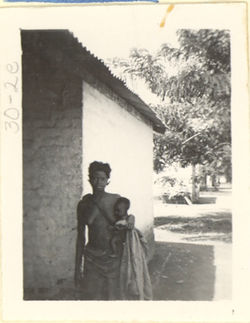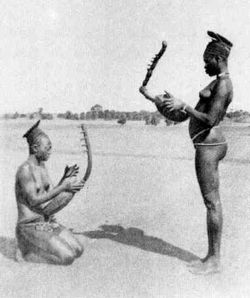Women in the Belgian Congo:
How Expressions of Feminity Changed Pre & Post Colonization
 |  |  |
|---|---|---|
 |  |  |
 |  |  |
 |  |  |
 |  |  |
Although many historians discuss the forced labor practices, physical and sexual abuse and callous murders the Congolese suffered at the hands of the Belgians during colonial rule, very few analyze how these heinous acts altered the Congolese peoples’ lifestyles and cultures. The Congo, before it was an unified state, consisted of a network of African kingdoms, villages, and tribes. Each tribe had its own cultural practices and lifestyle that were, in at least a small part, similar to the cultural practices of the tribes surrounding them. However, when the Belgians arrived they worked to impress “civilization” onto the Congolese people. Viewing the Congolese through a paternalistic lens, the Belgians did not consider the Congolese peoples’ culture simply different, but inferior. The Belgians used this racist sentiment to justify forcing Congolese men to labor as porters and rubber collectors, and if the men didn’t comply the Belgians held their women as hostages. This systematic forced labor practice not only exploited the land, but also the people, rendering them disposable and tools for profit.
Congolese women, who were the victims of both extreme racism and sexism, arguably underwent the most drastic cultural changes as a result of the Beligan occupation. Victorian culture dictates that a woman's body is inherently sexual while simultaneously condemning anything perceived as promiscuous. As a result, Victorian women were forced to cover their bodies (in clothing) to protect their modest, chastity, and piety. However, the concepts of modesty, chastity and piety (the Victorian interpretations) were foreign to the women of the Congo. The Congolese did not view the female body as inherently sexual. Most Congolese women wore no upper garments, exposing their breasts. In fact, Victorian men marveled at how the Congolese women dressed, viewing them through a sexualized, sexist and racist lens. When Congolese women were shipped to European for a zoo exhibit, the men waited in anticipation to see the Congolese womens’ breasts only to be disappointed when they realized the women were covered for the event. After the Belgian arrival in the Congo, particularly when missionaries became well-established, Congolese women were forced to cover their breasts and relinquish native dress.
The policing of Congolese women’s dress was simply another form of dominance and control. Like the sexual and physical abuse the Congolese women endured at the hands of the Belgians, forcing the Congolese women to change their dress was another way to subordinate them under cultural expectations and norms they were unfamiliar with. Victorian views of women were inherently hypersexual, and yet the expectation was that the women were meek and sexually repressed. Essentially, Victorian women could only be the innocent and pious object of male desire; Women had no agency. This sentiment plays directly into the commodification of Congolese women and why Belgian forces felt they were entitled to their bodies. Racism coupled with this Victorian view of women led to Belgian men seeing Congolese women as objects of their desire whom they could trade, rape, and beat without consequence. The change of dress, a visual indicator of the oppression the Congolese women faced, marked a significant cultural shift in what it meant to be a woman in the Congo.
Photo Collection (swipe to left)
Pre-Colonial Dress
1- Map Postcard
2- Dancing
3- Gathering
4- Women
5- Woman carrying child
6- Adolescent
7- Women carrying bananas
8- Women playing instruments
Colonial/Post Colonial Dress
9- Women held hostage
10- Three women, missionary postcard
11- Women churn butter with Nuns
12- Congolese Family
13- Mission Classroom
14- Mission Outdoors
15- Nun w Children
Works Cited
Carl de Keyzer. POSTCARD FROM CONGO: CARL DE KEYZER. Photograph. Accessed
January 20, 2021. https://bintphotobooks.blogspot.com/2011/10/
postcard-from-congo-carl-de-keyzer_10.html.
Denis, Armand. Second Leila Roosevelt Expedition - Armand Denis Belgian Congo
Expedition; 302. Photograph. Accessed January 20, 2021.
https://digitalarchives.broward.org/digital/collection/p16146coll13/id/1661/rec/
1.
Documentation of colonial abuses in Belgian Congo, ca. 1946- women with child.
Photograph. Accessed January 20, 2021. https://credo.library.umass.edu/view/
full/mums312-b104-i469.
Documentation of colonial abuses in Belgian Congo, ca. 1946- Woman carries
bananas. Photograph. https://credo.library.umass.edu/view/full/
mums312-b104-i469.
Documentation of colonial abuses in Belgian Congo, ca. 1946- adolescent.
Photograph. https://credo.library.umass.edu/view/full/mums312-b104-i469.
Gabriel, Leopold. Three women, kantanga, Belgian Congo. 1930. Photograph.
Accessed January 18, 2021. https://africa.si.edu/exhibits/focus/
photographers4.html.
Old Post Card, Mangbetu Women. Photograph. Accessed January 19, 2021.
https://africaafrika.tumblr.com/image/134689651749.
Society of African Mission Postcards - Box 1, Card 69. A photograph of a large
Congolese family whom are affiliated with the missionaries of
Coquilhatville (Mbandaka) Belgian Congo. Photograph.
Society of African Mission Postcards - Box 2, Card 92. An image of a missionary
Nun with native Congolese churning butter known as 'The Good Butter' in
Wadsa, Congo [Belgian Congo. Photograph. Accessed January 20, 2021.
https://digitalarchives.broward.org/digital/collection/p16146coll4/id/665/rec/
11.
Society of African Mission Postcards - Box 4, Card 152. A photograph of a
missionary Nun surrounded by Congolese children being taught an educational
lession at the Guardian School in Léopoldville (Kinshasa) Congo. [Belgian
Congo. Photograph. Accessed January 20, 2021.
https://digitalarchives.broward.org/digital/collection/p16146coll4/id/311/rec/
12.
Society of African Mission Postcards - Box 4, Card 23. A group photograph
depicting young Congolese females in an all-girls missionary facilitated
classroom located in the Belgian Congo. Accessed January 20, 2021.
https://digitalarchives.broward.org/digital/collection/p16146coll4/id/551/rec/
26.
Van Gent, Lode. Mangbetu Women, Belgian Congo. Photograph. Accessed January 18,
2021. https://vintagecongo.tumblr.com/post/119632613038/
mangbetu-women-belgian-congo-by-lode-van-gent.
Women Held Hostages, Belgian Congo. Photograph. Accessed January 19, 2021.
https://www.opensourceinvestigations.com/congo/
democratic-republic-congo-greed-meets-inhumanity/.